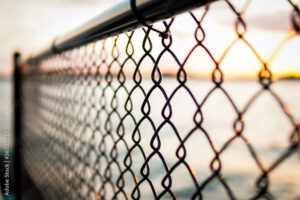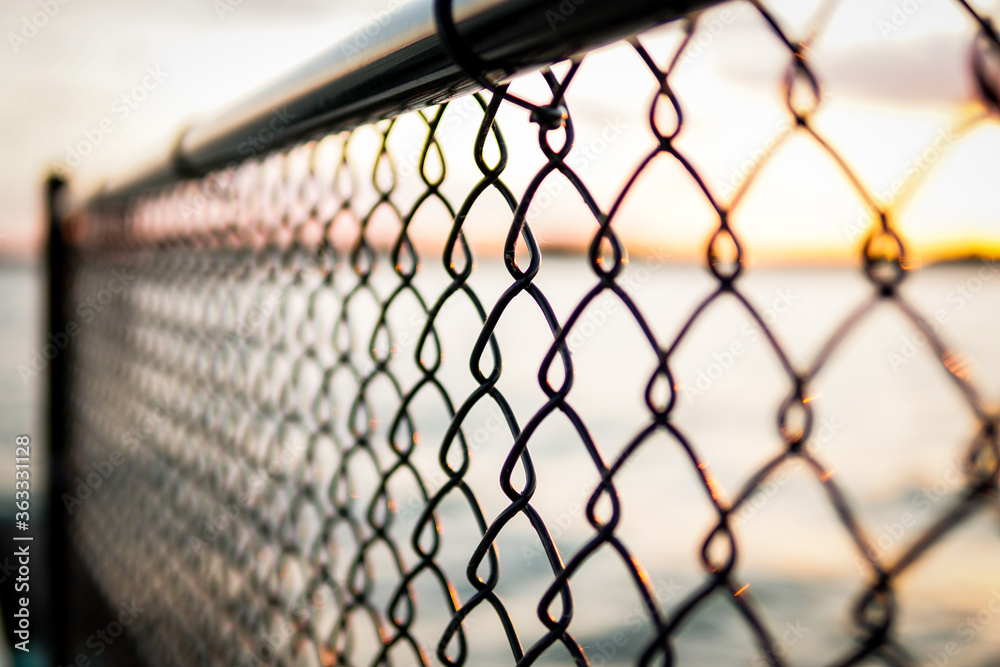Chain Link Fence
If you’re looking for a secure fence to keep pets, livestock, or other animals contained, Chain Link Fence New Jersey is the right choice. It’s relatively inexpensive and offers many benefits. Starting at one of the terminal posts, unroll and weave the chain link fabric. Once the material is complete, hook up the end of the chain link.

Chain link fences are a versatile option for both residential and commercial properties. They are also budget-friendly and provide high levels of security. Compared to other types of fencing, they require less maintenance and can last for years. Galvanized and aluminized chain link fencing will not rust or collect dirt, and they are available in a wide range of colors to suit your property.
The most common uses for this type of fencing include:
- Securing yards and sports fields.
- Delineating property lines.
- Providing safety around pools and playgrounds.
In addition to these uses, this fencing is also great for preventing vandalism, burglary, and accidental damage to buildings and equipment.
Choosing the correct grade is essential for any chain link fence project. There are three different grades: residential, commercial, and industrial. The quality is based on the gauge, or thickness, of the wires used to create the mesh fabric and the framework or pipe tubing size. The more dense the material and the larger the diameter of the tubing, the higher the grade of the fence.
Installing a chain link fence is relatively simple. Once the posts have been set, the top rail should be attached to the terminal post using a stick or chain link fitting. This is done to prevent the fence’s top from sagging and ensure that the tension bar is held in place.
After the top rail has been fixed, the chain-link fabric should be laid out and stretched to the desired length. Then, the end of each piece of cloth should be connected to a line wire using a clip or wire. Once the line wires are connected, they can be strained and closed up using knuckles or clips.
Once the netting has been stretched and closed up, the final step is to add privacy slats. These slats are small strips that weave in between the links of the fence and can be made from either aluminum or vinyl. The slats are often used to hide an unsightly area or to add protection for children and pets.
Chain link fences are a popular option for security purposes because they offer high visibility, which allows security personnel to see unwanted intruders easily. They are also relatively easy to maintain and can be easily repaired or replaced when damaged. In addition, the fact that they are made of galvanized steel means that they will not rust when exposed to water and other chemicals that can cause damage to different types of fencing materials.
In commercial applications, chain-link fences can be reinforced with barbed wire for protection. They are often used in areas where unauthorized entry into the site is a concern, such as parking lots or storage centers. The addition of barbed wire on top and bottom of the fence increases its difficulty to climb and broach. A bottom rail can also be added to reduce the possibility of someone crawling under the wall.
Residential chain-link fences provide property boundaries and safety for children and pets and meet local building codes required for swimming pools. In addition, they can be upgraded with gate systems that are lockable and automated for vehicle access. The fence can be further enhanced with visual deterrence using inserted barrier strips or spikes for added security.
Galvanized chain-link is the most common choice for residential use, but some customers prefer the look of powder-coated fencing. These options come in a wide range of colors and can match other aesthetic features of a home. They can also be installed with slats or privacy strips for privacy and beauty.
Many people may think a chain-link fence is too unsightly to be an attractive option for their homes, but that is not true. In reality, a chain-link bar can be an attractive feature on any home and increase its value. This is because prospective buyers pay attention to the appearance of a home and may be more interested in purchasing it if it has a beautiful fence. In addition, the low maintenance associated with chain-link borders can help improve a homeowner’s curb appeal.
Chain link fences can provide a strong barrier that reduces the chances of unwanted individuals or animals gaining access to your property. They also look more professional than many other types of fencing and have good durability. This makes them ideal for commercial properties and also for homeowners. They are a safe, economical choice for both indoor and outdoor use.
They are made up of a steel tubing framework and then covered with mesh fabric bent and interlocked together. The fabric itself comes in a variety of different gauges. The lower the gauge, the thicker and stronger the wire. It is then galvanized to create added corrosion resistance.
Residential chain link fences are typically knuckled at the top and bottom, which helps prevent children from climbing over the wall and being exposed to sharp edges that could hurt them. The size of the diamond openings – or spaces between each link – is another option that can be chosen for the fence. A larger diamond size provides more security, but a smaller one will reduce visibility.
You can add a privacy screen to make the fence more opaque and less see-through. This is a common feature that you will find at sports arenas, tennis courts, and other places that need a bit more privacy. However, the weather can damage the screen, and it should be replaced every few years.
For extra security, a third row of barbed or line wire can be added to the fence and run vertically or cranked, depending on your requirements. The additional rows are attached to the strainer posts (either concrete or angle iron), which are anchored into the ground and are placed at all corners, two-ways, and ends of the fence, as well as any changes in direction.
These are then connected to the end of the line post using a rail end band and fastened with a carriage bolt to ensure they are secure. The same process is used to connect the intermediate positions to the strainer posts, though these are not required for residential applications.
Preventative maintenance can go a long way to keeping your chain link fence secure for decades. If you notice that your bar is starting to sag or showing signs of wear and tear, don’t wait to call in a professional. If left unattended, these issues will only worsen and may require a more expensive repair.
Regularly cleaning your fence will help to keep it looking its best and free from any unwanted debris. Using your hose with a high setting to spray down your bar is an easy and effective way to clean away any dirt or debris buildup. You can use a scrub brush or soapy water to remove any bird feces or stuck-on stains for tougher spots.
You should also regularly check for any damage to your posts or other components of your fence. When a post is damaged, it can create weak spots in the wall, possibly leading to collapse. Checking your gate for damage is also important, as it could make the entrance less secure and more susceptible to being climbed or cut.
If your chain link fence is starting to rust, it’s time to refinish it. Commercial chain link fencing is typically made from galvanized steel coated with zinc for corrosion protection. Over time, the zinc coating can deteriorate, leaving the steel vulnerable to rusting and other corrosion. Rust can cause the metal to weaken and break, which can then cause holes in your fence.
Fortunately, refinishing your chain link fence is a simple process that can save you the cost of a more extensive and expensive repair job in the future. Purchase some metallic, anti-rust paint designed specifically for fencing and apply a coat to the areas where the galvanized coating has started to erode. You can also choose to recoat the entire fence if you’d like, though this is optional and may be more costly. Ensure you thoroughly inspect your wall and make any necessary repairs as soon as possible to avoid expensive repairs in the future.

